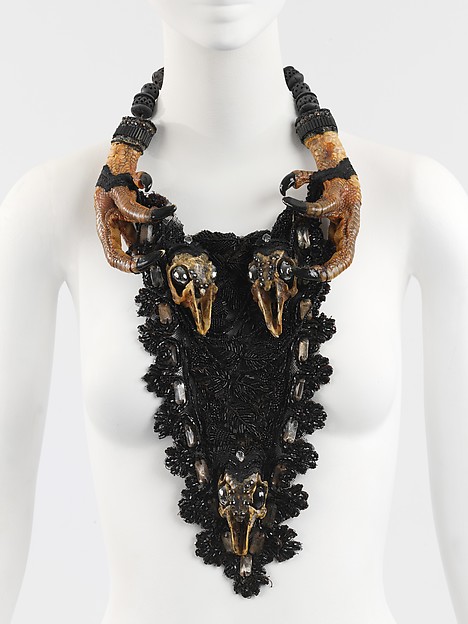To say Sarah Scaturro had me at “semen” is both entirely accurate and the oddest phrase I have ever put to virtual paper. To be precise, she had my interest at “Vials of evaporating semen…”, the jaw-dropping opener to her abstract, and she held it for her entire talk on the conservation of jewelry by Simon Costin contained within the Metropolitan Museum of Art’s Costume Institute collection.
The two necklaces of discussion were Memento Mori, made by Costin in 1986, and Incubus, made in 1987. Both presented unique preservation problems not frequently encountered by textile conservators. Faced with unfamiliar challenges, Scaturro sought first to better understand the mechanisms of degradation affecting the necklaces: this involved conducting artist interviews and consulting alternatives resources on taxidermy and liquid-preserved specimens.

In the case of Memento Mori, the turkey feet and rabbit skulls, incorporated into the necklace’s design, had begun to degrade due to insufficient preparation methods. The fats contained within the skin of the turkey feet had oxidized leading to a rancid odor – a smell all too familiar to me having recently completed the degreasing of beluga whale jawbones. The oxidized fats were also pooling at the surface of the feet, risking degradation of the neighboring necklace elements. The rabbit skulls, which retained some bits of flesh and hair, suffered from discoloration and mold, negatively impacting the artist’s intended aesthetics. Swabbing with ethanol proved to be the solution for both of Memento Mori’s problems – ethanol was used to degrease the surface of the turkey feet while it also acted as a biocide, killing the mold on the rabbit skulls, in addition to reducing the discoloration. Scaturro also employed preventive strategies which included the use of barriers to prevent transfer of the turkey fats to other parts of the necklace and anoxia to slow the oxidation of the fats.
The treatment of Incubus, the inspiration for the talk’s title and my grim interest, was still in progress at the time of Scaturro’s talk. The necklace, which resulted in a charge of indecency for the artist at the time of its unveiling, contains 5 vials of semen, one donation having been made by the artist himself. Over the past 30 years, the semen has discolored and partially evaporated – how best to address this issue, Scaturro was undecided. She raised two amusing points while discussing her research into the degradation mechanisms of Incubus: one, there is little information available on how semen degrades over thirty years; and two, it would be interesting to understand what elements of the five donations were responsible for the variations in color and evaporation rate.

Her first steps to the treatment of Incubus involved the creation of permanent upright storage for the necklace, thereby avoiding contact between the rubber stoppers on the vials and their contents. Scaturro made note that storage and display at a consistent temperature (as opposed to cold storage and room temperature display) was best practice for slowing the evaporation of the semen. She was also considering applying cyclododecane to improve the seal of the vials – the benefit of cyclododecane wax being its gradual sublimation at room temperature, making it possible to display the necklace without wax coatings affecting the aesthetics.
Scaturro concluded by noting that further interviews with Simon Costin were planned with the hopes that he might be able to offer direction as to the refilling or not of the vials of semen.
Overall, Scaturro handled the unusual topic with professionalism, inciting only minimal nervous giggling. The talk provided a window into the extremes of art and art conservation, and offered an example of how to approach the even the most macabre of objects.
Tag: taxidermy
C2CC Webinar 9/24/15: Troublesome Trophies and Fragile Feathered Friends: Introduction to the Care of Historic Taxidermy
Sign up now for the September 24, 2015 (1:00 – 2:30 EDT) Connecting to Collections Care webinar on caring for Taxidermy specimens. It’s Free.
http://www.connectingtocollections.org/troublesome-trophies-and-fragile-feathered-friends-introducti…
Troublesome Trophies and Fragile Feathered Friends: Introduction to the Care of Historic Taxidermy
Taxidermy mounts are challenging composite artifacts susceptible to damage from both environmental and biological factors. Whether a single trophy mount graces your historic home, several form a diorama in your museum, or you have a collection of natural science specimens, knowing how mounts are made, how they deteriorate and how to care for them is essential for their preservation. This webinar is an introduction to the care of taxidermy by a master taxidermist and an objects conservator. The presentation will cover what to look for in a mount to help determine its manner of construction and perhaps its age, how mounts typically deteriorate over time and how to provide proper preventive care. If refurbishment is necessary, taxidermists and conservators often have differing approaches and the presenters will describe what to expect from the process. Health and safety concerns in dealing with older mounts will also be covered.
Featured Speakers:
George Dante, Founder, Wildlife Preservations, has more than 30 years of experience as a taxidermist, model maker, illustrator and fine artist and Eugenie Milroy is a Professional Associate member of the American Institute for Conservation (AIC) with over 20 years of museum and conservation experience.
